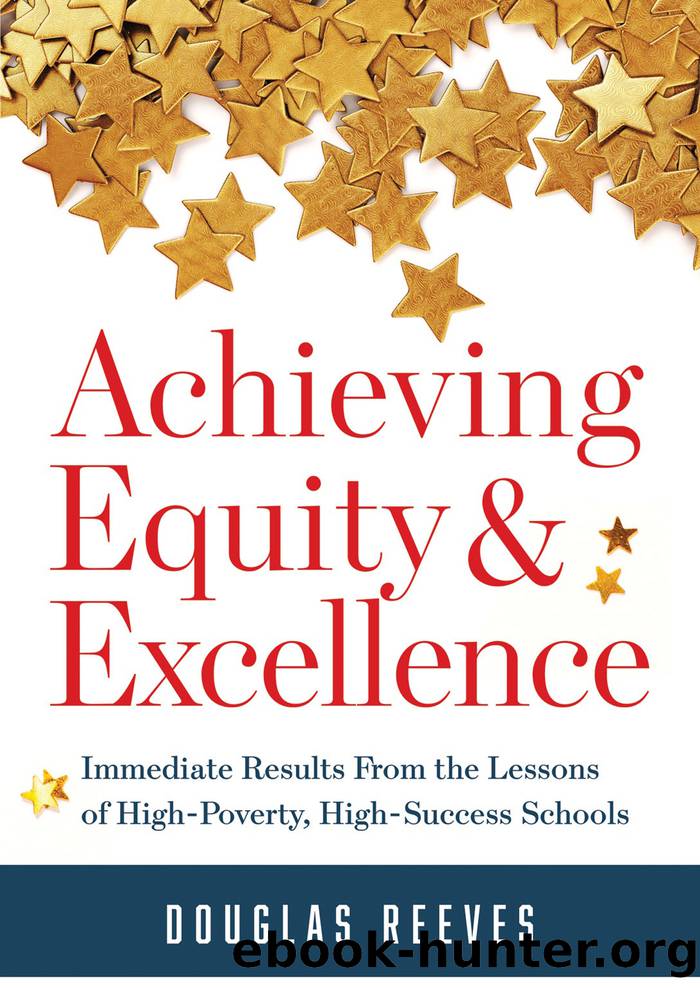Achieving Equity and Excellence by Reeves Douglas;

Author:Reeves, Douglas;
Language: eng
Format: epub
Publisher: Solution Tree
Published: 2019-08-15T00:00:00+00:00
CHAPTER 11
Change Behavior Before Belief
One of the biggest challenges in implementing equity and excellence techniques in your school is the inevitable resistance that accompanies any change initiative. Change of any sort represents a loss and is consequently often difficult and painful. It is important to acknowledge the challenges and difficulties associated with change and respect the feelings of colleagues when they are resistant to change. However, equity and excellence schools provide a model for how to successfully implement change. In this chapter, we will begin by discussing the difficulties of change and why it is particularly difficult in systems with high poverty. We will discuss traditional models for change and why they fail. Finally, we will present some techniques for how to manage change to bring about successful and rapid changes desperately needed in high-poverty schools.
Anticipating Resistance and Other Difficulties of Change
Change is hard because it represents lossâloss of previous practice and convictions and, most of all, loss of previous identity. For example, I hope my students turn to me when they need answers, and I hope to be the trusted colleague my peers turn to when facing their most difficult students. So, I am understandably threatened regarding my personal and professional identity as a subject-matter expert when my expertise is on a YouTube video that is more readily accessible than my office hours. When I have objective successâthe evidence of which is happy students; heartfelt letters from alumni and parents; and high test scores from Advanced Placement, International Baccalaureate, or other college credit classesâI am not terribly interested to know about alternative styles of pedagogy, assessment, and grading that might better serve my studentsâ interests. I am already successful, so any suggestion to improve is an implication that my success is invalid and illusory. Resistance to change is not a character defect. It is a reflection of the human condition that finds comfort and affirmation in previous practice. The central challenge for change leadership is to distinguish bad practice from the motivation behind bad practice.
Adam Grant (2019), a professor at the Wharton School at the University of Pennsylvania specializing in organizational psychology, reminds us that cultural change is painful and uncomfortable. Often, the weight-loss industry entices people not because it leads to weight loss, but because it promises pain-free change. Why endure sweat and deprivation when a pill or procedure will do? The same seductions can also occur in schools, as vendors lead decision makers to conclude that after-school programs, technology solutions, or other interventions can save underperforming students without inconvenient and uncomfortable actions requiring changes in schedule, restrictions on time, confrontations with parents, or otherwise difficult and uncomfortable decisions. But just as miracle weight-loss drugs or products are rarely effective, neither are change initiatives without some degree of hard work, discomfort, and yes, pain, as we say farewell to old and comfortable methods.
Even in school systems reporting high achievement, change can be difficult and painful. Chip Kimball, former superintendent of Singapore American School, the largest international school in
Download
This site does not store any files on its server. We only index and link to content provided by other sites. Please contact the content providers to delete copyright contents if any and email us, we'll remove relevant links or contents immediately.
Macmillan Primary Grammar 2 Pupil's Book by Unknown(388)
Figuring Out Fluency in Mathematics Teaching and Learning, Grades K-8 by Jennifer M. Bay-Williams & John J. SanGiovanni(355)
The Principal's Guide to Curriculum Leadership by Sorenson Richard D.;Goldsmith Lloyd M.;Mendez Zulma Y.;Maxwell Karen T.;(282)
English Grammar Practice--The Noun by Roxana Nastase(241)
Learning from Accidents 3rd ed by Trevor Kletz (2001)(238)
Harnessing Technology for Deeper Learning by Scott McLeod(229)
Text-Dependent Questions, Grades K-5 by Douglas Fisher & Nancy Frey & Heather Anderson & Marisol Thayre(216)
A Guide to Curriculum Mapping by Hale Janet A.;(214)
English Language Program Administration by Unknown(205)
How to Do Everything with Google Tools by Unknown(199)
Deep Change Leadership by Reeves Douglas;(197)
The Grammar Teacher's Activity-a-Day by Jack Umstatter(185)
The Power of SMART Goals by Conzemius Anne;O'Neill Jan; & Anne Conzemius(184)
Aligning and Balancing the Standards-Based Curriculum by Squires David A.;(164)
Beyond the RTI Pyramid by Bender William N.;(163)
Using Data to Close the Achievement Gap by Johnson Ruth S.;(158)
Differentiated Instructional Strategies for the Block Schedule by Gregory Gayle H.;Herndon Lynne E.; & Lynne E. Herndon(157)
Using Equity Audits to Create Equitable and Excellent Schools by Skrla Linda E.;McKenzie Kathryn B.;Scheurich James Joseph;(154)
You've Got to Reach Them to Teach Them by Schreck Mary Kim; & Schreck(144)
